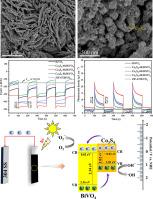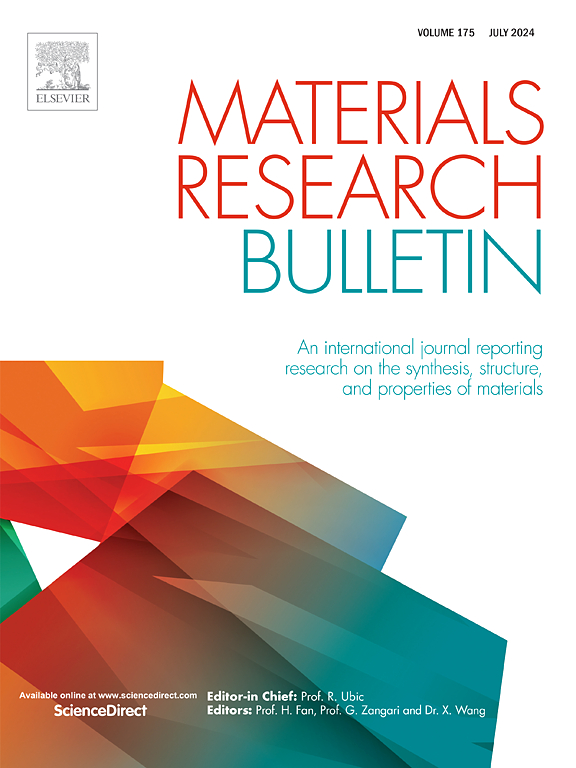Enhanced photocathodic protection performance of Co3S4 nanoparticles modified porous BiVO4 composites for 304 stainless steel
IF 5.3
3区 材料科学
Q2 MATERIALS SCIENCE, MULTIDISCIPLINARY
引用次数: 0
Abstract
A nanoporous Co3S4/BiVO4 composites were successfully fabricated via electrodeposition, immersion and oil-bath heating methods. ZIF-67 was used as a cobalt source and template. Co3S4/BiVO4 obtained by treatment for 6 h displayed the best photocathodic protection (PCP) performance. Under light, Co3S4–6 h/BiVO4 reduced the potential of 304 stainless steel (SS) to −490 mV vs. SCE, which was 200 mV below that of pure BiVO4. In addition, the photocurrent densities of 304 SS coupled with Co3S4–6 h/BiVO4 were up to 13 μA cm−2, which was more than 4 times that of pure BiVO4. Remarkably, the Rct of 304 SS coupled with Co3S4–6h/BiVO4 (142.6 Ω·cm2) was 1/27 of that of pure BiVO4 (3918 Ω·cm2). The outstanding PCP property of Co3S4/BiVO4 can be owed to the synergistic effects of strong visible light absorption, improved charge transfer efficiency, and enhanced electron storage capacity. These advantages make Co3S4/BiVO4 a promising candidate for providing effective PCP effects on metals.

用于 304 不锈钢的 Co3S4 纳米颗粒改性多孔 BiVO4 复合材料的光阴极保护性能得到增强
通过电沉积、浸泡和油浴加热方法,成功制备了纳米多孔 Co3S4/BiVO4 复合材料。ZIF-67 被用作钴源和模板。处理 6 小时后得到的 Co3S4/BiVO4 显示出最佳的光阴极保护(PCP)性能。在光照下,Co3S4-6 h/BiVO4 可将 304 不锈钢(SS)的电位降至 -490 mV,比纯 BiVO4 低 200 mV。此外,304 SS 与 Co3S4-6 h/BiVO4 耦合的光电流密度高达 13 μA cm-2,是纯 BiVO4 的 4 倍多。值得注意的是,与 Co3S4-6h/BiVO4 结合的 304 SS 的 Rct(142.6 Ω-cm2)是纯 BiVO4(3918 Ω-cm2)的 1/27。Co3S4/BiVO4 的出色 PCP 特性可归功于强可见光吸收、电荷转移效率提高和电子存储容量增强的协同效应。这些优势使 Co3S4/BiVO4 有希望成为一种能对金属产生有效的 PCP 效应的候选材料。
本文章由计算机程序翻译,如有差异,请以英文原文为准。
求助全文
约1分钟内获得全文
求助全文
来源期刊

Materials Research Bulletin
工程技术-材料科学:综合
CiteScore
9.80
自引率
5.60%
发文量
372
审稿时长
42 days
期刊介绍:
Materials Research Bulletin is an international journal reporting high-impact research on processing-structure-property relationships in functional materials and nanomaterials with interesting electronic, magnetic, optical, thermal, mechanical or catalytic properties. Papers purely on thermodynamics or theoretical calculations (e.g., density functional theory) do not fall within the scope of the journal unless they also demonstrate a clear link to physical properties. Topics covered include functional materials (e.g., dielectrics, pyroelectrics, piezoelectrics, ferroelectrics, relaxors, thermoelectrics, etc.); electrochemistry and solid-state ionics (e.g., photovoltaics, batteries, sensors, and fuel cells); nanomaterials, graphene, and nanocomposites; luminescence and photocatalysis; crystal-structure and defect-structure analysis; novel electronics; non-crystalline solids; flexible electronics; protein-material interactions; and polymeric ion-exchange membranes.
 求助内容:
求助内容: 应助结果提醒方式:
应助结果提醒方式:


